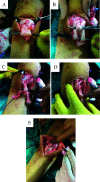Evaluation of infrapatellar tendon plication in spastic cerebral palsy with crouch gait pattern: a pilot study
- PMID: 33030425
- PMCID: PMC7543689
- DOI: 10.1051/sicotj/2020037
Evaluation of infrapatellar tendon plication in spastic cerebral palsy with crouch gait pattern: a pilot study
Abstract
Objective: In order to substantially improve crouch pattern in cerebral palsy, the existent patella alta needs to be addressed. This pilot study evaluates the effectiveness of a previously described infrapatellar tendon plication for the treatment of patella alta in crouch gait pattern in skeletally immature spastic cerebral palsy patients.
Methods: In 10 skeletally immature patients (20 knees) with spastic diplegia and crouch gait, the previously described technique by Joseph et al. for infrapatellar tendon plication was evaluated within the setting of single event multilevel surgery (SEMLS). Outcome measures included knee extension lag, Koshino's radiological index for patella alta, and the occurrence of complications. Patients were followed-up for a minimum of 12 months.
Results: The extensor lag improved and was statistically significant in all cases of the study with no incidence of tibial apophyseal injury at the latest follow-up. Radiographic Koshino index normalized and was maintained all through the follow-up period except in one patient (5%) who was overcorrected. Two patients (4 knees, 20%) showed postoperative knee stiffness due to casting which resolved with physiotherapy within six weeks. One knee (5%) developed a superficial infection which also resolved uneventfully with repeated dressings.
Conclusion: The described infra-patellar plication technique in skeletally immature spastic diplegics appears effective, safe, and reproducible.
Keywords: Cerebral palsy; Crouch gait; Moment arm; Patella alta; Patellar tendon plication; Pediatric knee.
© The Authors, published by EDP Sciences, 2020.
Figures



References
-
- Rogozinski BM, Davids JR, Davis RB, Jameson GG, Blackhurst DW (2009) The efficacy of the floor-reaction ankle-foot orthosis in children with cerebral palsy. J Bone Jt Surg – Ser A 91, 2440–2447. - PubMed
-
- Joseph B, Reddy K, Varghese RA, Shah H, Doddabasappa SN (2010) Management of severe crouch gait in children and adolescents with cerebral palsy. J Pediatr Orthop 30, 832–839. - PubMed
-
- Koshino T, Sugimoto K (1989) New measurement of patellar height in the knees of children using the epiphyseal line midpoint. J Pediatr Orthop Part B 9, 216–218. - PubMed
-
- Nahm NJ, Graham HK, Gormley ME, Georgiadis AG (2018) Management of hypertonia in cerebral palsy. Curr Opin Pediatr 30, 57–64. - PubMed
-
- Novacheck TF, Stout JL, Gage JR, Schwartz MH (2009) Distal femoral extension osteotomy and patellar tendon advancement to treat persistent crouch gait in cerebral palsy. Surgical technique. J Bone Joint Surg Am 91(Suppl 2), 271–286. - PubMed
LinkOut - more resources
Full Text Sources
